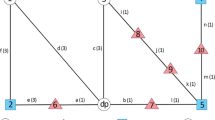Abstract
Emergency relief distribution plays a vital role during disaster responding. This paper studies routes selection and transportation time moment selection for emergency relief distribution along with disaster information updating. This paper derives a new definition for route reliability, which is a combination of multiple routes according to three factors: reliability of each edge, the number of dissimilar detour paths, and dissimilarity of multiple routes. Transportation time moment is determined according to disaster information updating accuracy rate. A multi-objective mathematical programming is formulated for route planning problem. The objective function consists route reliability and information accuracy rate. Then we present an ant colony optimization algorithm to solve this problem. Disaster information update process is clarified, as well as propose a new way to evaluate multiple routes reliability and applying an improved ant colony optimization algorithm. Finally, an earthquake around Ludian in Yunnan Provence is considered as a disaster scenario to analyze our model and algorithm, include the optimal solution, parameters’ impact on objective function, and performance of our algorithms.





Similar content being viewed by others
References
AQSIQ (2009) Chinese seismic intensity scale. Standards Press of China, Beijing
Chen T, Huang J, Zhu J (2015) Two-stage robust stochastic decision model for relief allocation based on disaster scenario information update. Chin J Manag Sci 23(10):67–77
Corley H, Sha DY (1982) Most vital links and nodes in weighted networks. Oper Res Lett 1(4):157–160
Dorigo M, Maniezzo V, Colorni A (1996) Ant system: optimization by a colony of cooperating agents. IEEE Trans Syst Man Cybern Part B (Cybernetics) 26(1):29–41
Duan H, Wang D, Zhu J, Huang X (2004) Development on ant colony algorithm theory and its application. Control Decis 19(12):1321–1326
Fan YD, Yang SQ, Wang L, Wang W, Nie J, Bj Zhang (2008) Study on urgent monitoring and assessment in Wenchuan Earthquake. J Remote Sens 6:005
Ge H (2012) Study on relief allocation models based on characteristics of disaster situation information. Master’s thesis, Zhejiang University
Hu JH, Zhong GP, Yan GC et al (2012) Design and implementation of dynamic emergency resources scheduling based on GIS. Appl Res Comput 1:057
Jovanovic R, Bousselham A, Voß S (2018) Partitioning of supply/demand graphs with capacity limitations: an ant colony approach. J Comb Optim 35(1):224–249
Kang Y, Batta R, Kwon C (2014) Generalized route planning model for hazardous material transportation with var and equity considerations. Comput Oper Res 43:237–247
Li Y, Wang L, Liu L (2009) Forecasting of transportation network for earthquake damage and its application in mountainous cities. J Southwest Jiaotong Univ 4(22):171–176
Liang L (2010) The depth-first traversal method for finding all paths between two nodes. Sci Technol Inf 33:86–87
Liu M, Xu Y (2006) The most vital links of transportation network under uncertain information. Syst Eng 24(12):16–20
Lodree EJ Jr, Taskin S (2009) Supply chain planning for hurricane response with wind speed information updates. Comput Oper Res 36(1):2–15
Nardelli E, Proietti G, Widmayer P (1998) Finding the detour-critical edge of a shortest path between two nodes. Inf Process Lett 67(1):51–54
Pushak Y, Hare W, Lucet Y (2016) Multiple-path selection for new highway alignments using discrete algorithms. Eur J Oper Res 248(2):415–427
Song L, Huang H, Du H (2016) Approximation schemes for Euclidean vehicle routing problems with time windows. J Comb Optim 32(4):1217–1231
Sun J, Shuai X, Li Z (2013) Intensity attenuation model of strong earthquakes in Southwest China. Earthquake 33(3):51–59
Xu W, Sun J, Lin L, Du K (2012) Study on real-time correction methods in rapid assessment of seismic intensity distribution. Dizhen Gongcheng yu Gongcheng Zhendong (Earthquake Eng Eng Vib) 32(4):34–39
Ye Y (2013) Follow-up sharing and group information update-based optimal scheduling of resource distribution for post-earthquake response. Master’s thesis, Zhejiang University
Acknowledgements
This work was supported in part by China National Science Foundation (CNSF) under Grant Nos. 71001099, 91324012.
Author information
Authors and Affiliations
Corresponding author
Additional information
Publisher's Note
Springer Nature remains neutral with regard to jurisdictional claims in published maps and institutional affiliations.
Rights and permissions
About this article
Cite this article
Zhu, J., Liu, S. & Ghosh, S. Model and algorithm of routes planning for emergency relief distribution in disaster management with disaster information update. J Comb Optim 38, 208–223 (2019). https://doi.org/10.1007/s10878-018-00377-8
Published:
Issue Date:
DOI: https://doi.org/10.1007/s10878-018-00377-8




